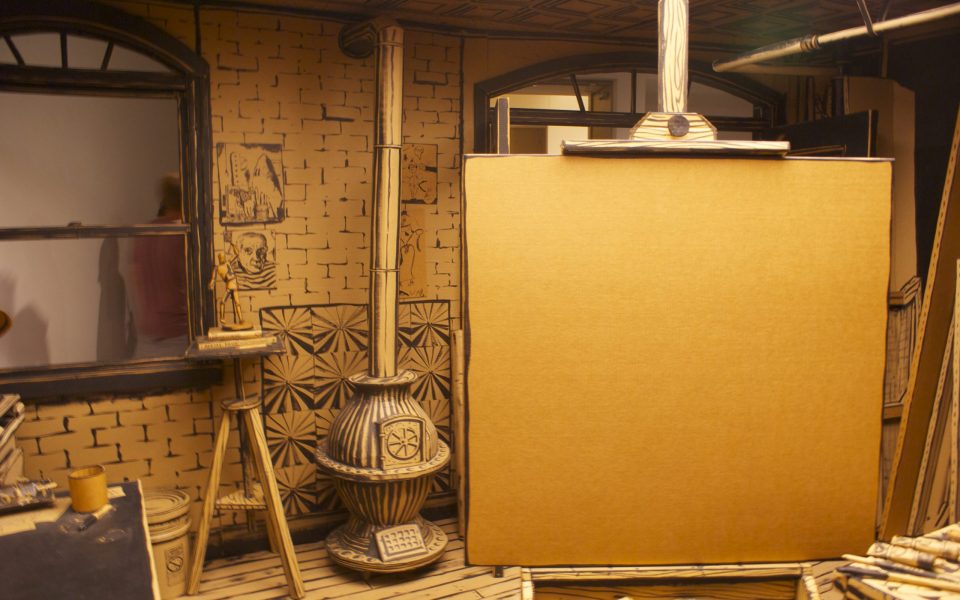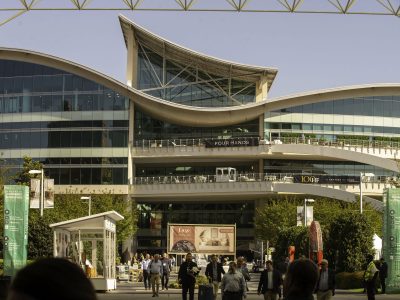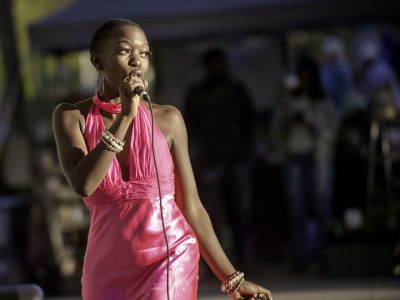by Anthony Harrison
Thunderstorms threatened the 11th annual summer solstice party at Greensboro’s Weatherspoon Gallery. But the threat of simple rain could not keep people from marveling at a full-scale, cardboard studio.
Arts intelligentsia and laypeople alike showed up in droves to celebrate the middle of the year with music, food and beer, as well as appreciate the two exhibits opening for the next few months, McDonald Bane’s 2 Parts Art, 1 Part Science and Tom Burckhardt’s Full Stop.
Attendees milled around the atrium and front courtyard early during party, enjoying either the offerings of the food trucks from Empanadas Borinquen, Taqueria El Azteca, Repicci’s Italian Ice or the complimentary fruit-and-veg or cheese plates offered along with wine and beer.
But no one came for the food and drink alone.
Bane’s exhibit occupies the Falk Gallery; the installation shows off six decades of her art, composed of geometric experimentation, from simple shapes to trippy waveforms.
“As a student here, I found it hard to connect with abstract expressionism,” Bane said, who attended UNCG in the ’60s while the movement was in vogue.
Using her background in science, which she studied at Virginia Tech in the ’50s, Mackey — as she’s known to friends — began crafting art using tools such as a compass, a straight-edge and a flexible curve, a pliable string of lead encased in plastic, to create geometric patterns.
With these tools and tactics, Bane produced art composed of deceptively simple patterns predating and foretelling the complexity of fractal configurations.
“I’ve always been more interested in the pure visual experience rather than telling a story,” Bane said. “I’ve done very little realistic work.”
Ironically, a still life of hers resides in the Museum of Modern Art in New York City.
While Bane believes she faltered as an expressionist, her work still falls under the mid-century movement’s aesthetic of non-representational imagery inspiring unconscious thought and reflection.
She also said none of her pieces evoke any kind of narrative, instead referring to the intangibility of color theory and music and what they arouse for the subjective experience.
Yet “2000” and “2001,” two pieces drawn in ink on paper, are clearly complementary pieces, though the second came as an unintentional sequel. “2001” shows the waveform, curved pyramid of “2000” crumpled to rubble, calling to mind the World Trade Center towers.
“I drew [‘2000’] in the year 2000, relating to a building in London, but I can’t remember what it was exactly,” Bane said. “After 9/11, I decided to do ‘2001.’”
Tom Burckhardt’s installation in the Tannenbaum Gallery, Full Stop, was something completely different, but more monumental. Yet it was microcosmic at the same time — an enormous, cardboard storefront, projecting outward ideas against oppression and authoritarian abuse, and inside, a promotion of the eclecticism of the artist’s world.
From inside out, it stands as a complex labor of love, the work of a fertile mind both unsure of what to do next yet driven by obscenely undeniable talent.
Burckhardt completed Full Stop after eight months of work, and considering the minutiae projected in the piece, that in itself is a miracle. The graffiti on the outside of the fake storefront itself was changed for this current iteration, and it reflects the attention to detail seen on the inside: “REMEMBER FURGUSSON” is scrawled below a window, and a “BLACK LIVES MATTER” sticker hangs directly above the door to the studio. Posters and stickers from previous eras — whether they say, “BUSH SUCKS,” or, “I AM A MAN” — remain prominent messages relevant to both the current day and the work on the inside.
But you have to remember these stickers and flyers aren’t technically real — it’s just black paint on cardboard.
The realism amplifies once you walk through the door.
Burckhardt laid out an artist’s studio in full, from tools and supplies to the philosophical books on the shelves and the photos of Nefertiti, paintings of Mark Rothko and Piet Mondrian, Hank Williams and Robert Johnson, to the record player featuring “West End Blues” by Louis Armstrong and His Hot Five and the abridged view of the New York City skyline in 3-D. Burckhardt nailed everything, even the shotgun bathroom with a tiny toilet. The only bare piece in the installation is an empty canvas — also cardboard — surely representing his next move.
Full Stop is a megalithic masterpiece.
During the party, despite the live music outside, many filed in and out of both installations — and in again, and out again and in again. It was behavior you’d expect to see at the hors d’oeuvres table out front rather than inside the gallery.
But people just couldn’t keep away.
2 Parts Art, 1 Part Science and Full Stop are both on exhibit at Weatherspoon Art Museum through Oct. 4.
Join the First Amendment Society, a membership that goes directly to funding TCB‘s newsroom.
We believe that reporting can save the world.
The TCB First Amendment Society recognizes the vital role of a free, unfettered press with a bundling of local experiences designed to build community, and unique engagements with our newsroom that will help you understand, and shape, local journalism’s critical role in uplifting the people in our cities.
All revenue goes directly into the newsroom as reporters’ salaries and freelance commissions.







Leave a Reply